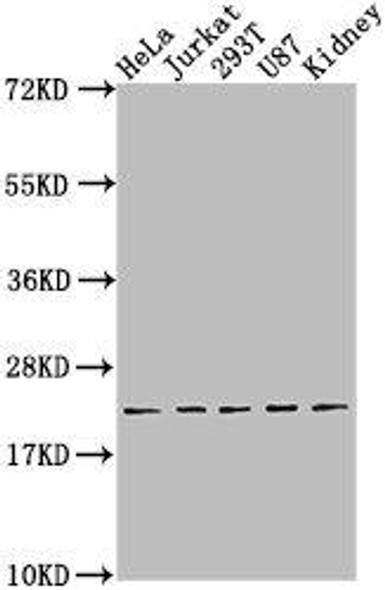BBC3 Antibody (PACO01380)
- SKU:
- PACO01380
- Product type:
- Antibody
- Reactivity:
- Human
- Mouse
- Rat
- Host Species:
- Rabbit
- Isotype:
- IgG
- Application:
- ELISA
- Application:
- WB
- Antibody type:
- Polyclonal
- Conjugation:
- Unconjugated
Frequently bought together:
Description
| Antibody Name: | BBC3 Antibody |
| Antibody SKU: | PACO01380 |
| Size: | 50ug |
| Host Species: | Rabbit |
| Tested Applications: | ELISA, WB |
| Recommended Dilutions: | WB:1:500-1:2000 |
| Species Reactivity: | Human, Mouse, Rat |
| Immunogen: | synthesized peptide derived from the C-terminal region of human PUMA. |
| Form: | Liquid |
| Storage Buffer: | Liquid in PBS containing 50% glycerol, 0.5% BSA and 0.02% sodium azide. |
| Purification Method: | The antibody was affinity-purified from rabbit antiserum by affinity-chromatography using epitope-specific immunogen. |
| Clonality: | Polyclonal |
| Isotype: | IgG |
| Conjugate: | Non-conjugated |
| Synonyms: | BBC3; PUMA; Bcl-2-binding component 3; JFY-1; p53 up-regulated modulator of apoptosis |
| UniProt Protein Function: | PUMA: Essential mediator of p53/TP53-dependent and p53/TP53- independent apoptosis. Interacts with MCL1 and BCL2A1. Interacts with BCL2 and BCL2L1/BCL-XL. By DNA damage, glucocorticoid treatment, growth factor deprivation and p53/TP53. Ubiquitously expressed. Belongs to the Bcl-2 family. 4 isoforms of the human protein are produced by alternative splicing. |
| UniProt Protein Details: | Protein type:Mitochondrial Chromosomal Location of Human Ortholog: 19q13.3-q13.4 Cellular Component: mitochondrial outer membrane; mitochondrion; cytosol Molecular Function:protein binding Biological Process: caspase activation; release of cytochrome c from mitochondria; positive regulation of protein homooligomerization; apoptosis; reduction of endoplasmic reticulum calcium ion concentration; positive regulation of neuron apoptosis; release of sequestered calcium ion into cytosol; determination of adult life span; response to DNA damage stimulus; negative regulation of growth |
| NCBI Summary: | This gene encodes a member of the BCL-2 family of proteins. This family member belongs to the BH3-only pro-apoptotic subclass. The protein cooperates with direct activator proteins to induce mitochondrial outer membrane permeabilization and apoptosis. It can bind to anti-apoptotic Bcl-2 family members to induce mitochondrial dysfunction and caspase activation. Because of its pro-apoptotic role, this gene is a potential drug target for cancer therapy and for tissue injury. Alternative splicing results in multiple transcript variants. [provided by RefSeq, Dec 2011] |
| UniProt Code: | Q9BXH1 |
| NCBI GenInfo Identifier: | 56748610 |
| NCBI Gene ID: | 27113 |
| NCBI Accession: | Q9BXH1.1 |
| UniProt Secondary Accession: | Q9BXH1,O00171, Q96PG9, B9EGI3, |
| UniProt Related Accession: | Q96PG8,Q9BXH1 |
| Molecular Weight: | 193 |
| NCBI Full Name: | Bcl-2-binding component 3 |
| NCBI Synonym Full Names: | BCL2 binding component 3 |
| NCBI Official Symbol: | BBC3 |
| NCBI Official Synonym Symbols: | JFY1; PUMA; JFY-1 |
| NCBI Protein Information: | bcl-2-binding component 3; p53 up-regulated modulator of apoptosis |
| UniProt Protein Name: | Bcl-2-binding component 3 |
| UniProt Synonym Protein Names: | JFY-1; p53 up-regulated modulator of apoptosis |
| Protein Family: | Bcl-2-binding component |
| UniProt Gene Name: | BBC3 |
| UniProt Entry Name: | BBC3_HUMAN |










